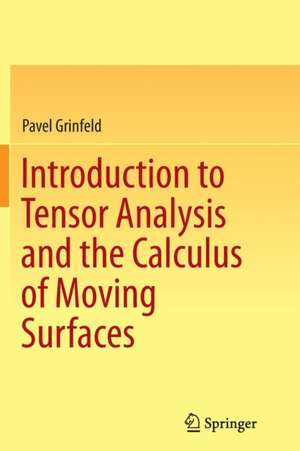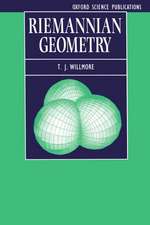Introduction to Tensor Analysis and the Calculus of Moving Surfaces
Autor Pavel Grinfelden Limba Engleză Paperback – 23 aug 2016
Designed for advanced undergraduate and graduate students, this text invites its audience to take a fresh look at previously learned material through the prism of tensor calculus. Once the framework is mastered, the student is introduced to new material which includes differential geometry on manifolds, shape optimization, boundary perturbation and dynamic fluid film equations.
The language of tensors, originally championed by Einstein, is as fundamental as the languages of calculus and linear algebra and is one that every technical scientist ought to speak. The tensor technique, invented at the turn of the 20th century, is now considered classical. Yet, as the author shows, it remains remarkably vital and relevant. The author’s skilled lecturing capabilities are evident by the inclusion of insightful examples and a plethora of exercises. A great deal of material is devoted to the geometric fundamentals, the mechanics of change of variables, the proper use of the tensor notation and the discussion of the interplay between algebra and geometry. The early chapters have many words and few equations. The definition of a tensor comes only in Chapter 6 – when the reader is ready for it. While this text maintains a consistent level of rigor, it takes great care to avoid formalizing the subject.
The last part of the textbook is devoted to the Calculus of Moving Surfaces. It is the first textbook exposition of this important technique and is one of the gems of this text. A number of exciting applications of the calculus are presented including shape optimization, boundary perturbation of boundary value problemsand dynamic fluid film equations developed by the author in recent years. Furthermore, the moving surfaces framework is used to offer new derivations of classical results such as the geodesic equation and the celebrated Gauss-Bonnet theorem.
| Toate formatele și edițiile | Preț | Express |
|---|---|---|
| Paperback (1) | 389.31 lei 6-8 săpt. | |
| Springer – 23 aug 2016 | 389.31 lei 6-8 săpt. | |
| Hardback (1) | 496.01 lei 6-8 săpt. | |
| Springer – 24 sep 2013 | 496.01 lei 6-8 săpt. |
Preț: 389.31 lei
Nou
Puncte Express: 584
Preț estimativ în valută:
74.49€ • 77.99$ • 61.64£
74.49€ • 77.99$ • 61.64£
Carte tipărită la comandă
Livrare economică 05-19 aprilie
Preluare comenzi: 021 569.72.76
Specificații
ISBN-13: 9781493955053
ISBN-10: 1493955055
Pagini: 315
Ilustrații: XIII, 302 p. 37 illus., 4 illus. in color.
Dimensiuni: 155 x 235 x 17 mm
Greutate: 0.45 kg
Ediția:Softcover reprint of the original 1st ed. 2013
Editura: Springer
Colecția Springer
Locul publicării:New York, NY, United States
ISBN-10: 1493955055
Pagini: 315
Ilustrații: XIII, 302 p. 37 illus., 4 illus. in color.
Dimensiuni: 155 x 235 x 17 mm
Greutate: 0.45 kg
Ediția:Softcover reprint of the original 1st ed. 2013
Editura: Springer
Colecția Springer
Locul publicării:New York, NY, United States
Cuprins
Preface.- Why Tensor Calculus?.- 1. Rules of the Game.- 2. Coordinate Systems and the Role of Tensor Calculus.- 3. Change of Coordinates.- 4. Tensor Description of Euclidean Spaces.- 5. The Tensor Property.- 6. Covariant Differentiation.- 7. Determinants and the Levi-Civita Symbol.- 8. Tensor Description of Surfaces.- 9. Covariant Derivative of Tensors with Surface Indices.- 10. The Curvature Tensor.- 11. Covariant Derivative of Tensors with Spatial Indices.- 12. Integration and Gauss's Theorem.- 13. Intrinsic Features of Embedded Surfaces.- 14. Further Topics in Differential Geometry.- 15. Classical Problems in the Calculus of Variations.- 16. Equations of Classical Mechanics.- 17. Equations of Continuum Mechanics.- 18. Einstein's Theory of Relativity.- 19. The Rules of Calculus of Moving Surfaces.- 20. Applications of the Calculus of Moving Surfaces.
Recenzii
From the book reviews:
“The textbook is meant for advanced undergraduate and graduate audiences. It is a common language among scientists and can help students from technical fields see their respective fields in a new and exiting way.” (Maido Rahula, zbMATH, Vol. 1300, 2015)
“This book attempts to give careful attention to the advice of both Cartan and Weyl and to present a clear geometric picture along with an effective and elegant analytical technique … . it should be emphasized that this book deepens its readers’ understanding of vector calculus, differential geometry, and related subjects in applied mathematics. Both undergraduate and graduate students have a chance to take a fresh look at previously learned material through the prism of tensor calculus.” (Andrew Bucki, Mathematical Reviews, November, 2014)
“The textbook is meant for advanced undergraduate and graduate audiences. It is a common language among scientists and can help students from technical fields see their respective fields in a new and exiting way.” (Maido Rahula, zbMATH, Vol. 1300, 2015)
“This book attempts to give careful attention to the advice of both Cartan and Weyl and to present a clear geometric picture along with an effective and elegant analytical technique … . it should be emphasized that this book deepens its readers’ understanding of vector calculus, differential geometry, and related subjects in applied mathematics. Both undergraduate and graduate students have a chance to take a fresh look at previously learned material through the prism of tensor calculus.” (Andrew Bucki, Mathematical Reviews, November, 2014)
Notă biografică
Pavel Grinfeld is currently a professor of mathematics at Drexel University, teaching courses in linear algebra, tensor analysis, numerical computation, and financial mathematics. Drexel is interested in recording Grinfeld's lectures on tensor calculus and his course is becoming increasingly popular. Visit Professor Grinfeld's series of lectures on tensor calculus on YouTube's playlist: http://bit.ly/1lc2JiY http://bit.ly/1lc2JiY
Also view the author's Forum/Errata/Solution Manual (Coming soon): http://bit.ly/1nerfEf
The author has published in a number of journals including 'Journal of Geometry and Symmetry in Physics' and 'Numerical Functional Analysis and Optimization'. Grinfeld received his PhD from MIT under Gilbert Strang.
Also view the author's Forum/Errata/Solution Manual (Coming soon): http://bit.ly/1nerfEf
The author has published in a number of journals including 'Journal of Geometry and Symmetry in Physics' and 'Numerical Functional Analysis and Optimization'. Grinfeld received his PhD from MIT under Gilbert Strang.
Textul de pe ultima copertă
This text is meant to deepen its readers’ understanding of vector calculus, differential geometry and related subjects in applied mathematics. Designed for advanced undergraduate and graduate students, this text invites its audience to take a fresh look at previously learned material through the prism of tensor calculus. Once the framework is mastered, the student is introduced to new material which includes differential geometry on manifolds, shape optimization, boundary perturbation, and dynamic fluid film equations.
Tensor calculus is a powerful tool that combines the geometric and analytical perspectives and enables us to take full advantage of the computational utility of coordinate systems. The tensor approach can be of benefit to members of all technical sciences including mathematics and all engineering disciplines. If calculus and linear algebra are central to the reader’s scientific endeavors, tensor calculus is indispensable. The language of tensors, originally championed by Einstein, is as fundamental as the languages of calculus and linear algebra and is one that every technical scientist ought to speak. The tensor technique, invented at the turn of the 20th century, is now considered classical. Yet, as the author shows, it remains remarkably vital and relevant. The author’s skilled lecturing capabilities are evident by the inclusion of insightful examples and a plethora of exercises. A great deal of material is devoted to the geometric fundamentals, the mechanics of change of variables, the proper use of the tensor notation, and the discussion of the interplay between algebra and geometry. The early chapters have many words and few equations. The definition of a tensor comes only in Chapter 6 – when the reader is ready for it. While this text maintains a reasonable level of rigor, it takes great care to avoid formalizing the subject.
The last part of the textbook is devoted to the calculus of moving surfaces.It is the first textbook exposition of this important technique and is one of the gems of this text. A number of exciting applications of the calculus are presented including shape optimization, boundary perturbation of boundary value problems, and dynamic fluid film equations developed by the author in recent years. Furthermore, the moving surfaces framework is used to offer new derivations of classical results such as the geodesic equation and the celebrated Gauss–Bonnet theorem.
Tensor calculus is a powerful tool that combines the geometric and analytical perspectives and enables us to take full advantage of the computational utility of coordinate systems. The tensor approach can be of benefit to members of all technical sciences including mathematics and all engineering disciplines. If calculus and linear algebra are central to the reader’s scientific endeavors, tensor calculus is indispensable. The language of tensors, originally championed by Einstein, is as fundamental as the languages of calculus and linear algebra and is one that every technical scientist ought to speak. The tensor technique, invented at the turn of the 20th century, is now considered classical. Yet, as the author shows, it remains remarkably vital and relevant. The author’s skilled lecturing capabilities are evident by the inclusion of insightful examples and a plethora of exercises. A great deal of material is devoted to the geometric fundamentals, the mechanics of change of variables, the proper use of the tensor notation, and the discussion of the interplay between algebra and geometry. The early chapters have many words and few equations. The definition of a tensor comes only in Chapter 6 – when the reader is ready for it. While this text maintains a reasonable level of rigor, it takes great care to avoid formalizing the subject.
The last part of the textbook is devoted to the calculus of moving surfaces.It is the first textbook exposition of this important technique and is one of the gems of this text. A number of exciting applications of the calculus are presented including shape optimization, boundary perturbation of boundary value problems, and dynamic fluid film equations developed by the author in recent years. Furthermore, the moving surfaces framework is used to offer new derivations of classical results such as the geodesic equation and the celebrated Gauss–Bonnet theorem.
Caracteristici
Is a self-contained introduction to tensor calculus containing over 150 exercises Presents a clear geometric picture combined with an effective and elegant analytical technique Uses an informal approach, focuses on concrete objects, and appeals to the reader's intuition with regard to fundamental concepts such as the Euclidean space, surface, and length Covers the subject of tensor calculus in greater depth than existing published texts Includes supplementary material: sn.pub/extras















